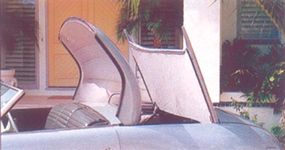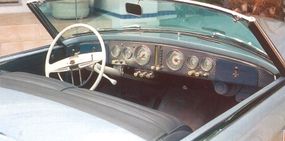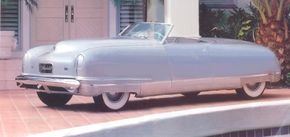Form follows function. Chrysler discredited that maxim with the aerodynamic Airflow of 1934. It was a disappointment both in appearance and in the marketplace, but Alex Tremulis, of Briggs Manufacturing's styling department, believed a couple of streamlined show cars -- including the 1941 Chrysler Thunderbolt Roadster -- would help restore Chrysler's reputation.
Advertisement
The cars would be constructed by Briggs-owned LeBaron in less than five months -- among the last cars built by the famous coachbuilder. The Golden Arrow and Thunderbolt land speed-record cars served as inspiration; "The Measured Mile Creates a New Motor Car" was the theme behind the two show cars.
In reality, neither car looked like its namesake. The Golden Arrow was renamed Newport at the last minute. A graceful dual-cowl phaeton, it would later pace the 1941 Indianapolis 500.

The Thunderbolt (named for Captain George Eyston's 357.5-mph record holder of 1938) was a two-door with retractable metal top. Pushbuttons controlled the hidden headlights, windows, rear deck, and top.
The Thunderbolt featured a full-envelope body with ribbed rocker panels inspired by Budd streamliner trains. The curved-glass windshield was the largest attempted at that time. The wraparound grille bar influenced the later Chrysler "harmonica" grille and hidden headlights turned up on 1942 DeSotos.

A standard 1941 New Yorker/Saratoga chassis was used with an Imperial 143-horsepower L-head straight-eight mated to Fluid Drive, a torque converter that could be used to eliminate most shifting and clutch work. The system was smooth but sluggish.
The first Chrysler Thunderbolt was completed in time for the New York Auto Show. Five more followed with slight trim variations and were shown across the country. All were eventually sold at prices starting at $6,000.

Four Thunderbolts are known to survive. The one featured here is owned by the Blackhawk Collection, of Danville, California, and is authentically restored, according to Chrysler records.
Advertisement
